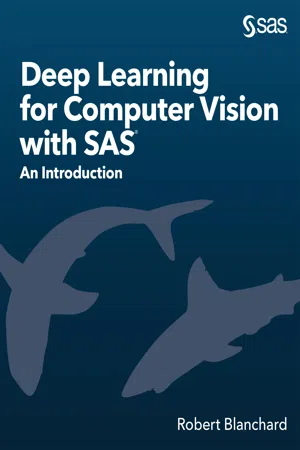
- 150 pages
- English
- ePUB (mobile friendly)
- Available on iOS & Android
eBook - ePub
About this book
Discover deep learning and computer vision with SAS!
Deep Learning for Computer Vision with SAS ®: An Introduction introduces the pivotal components of deep learning. Readers will gain an in-depth understanding of how to build deep feedforward and convolutional neural networks, as well as variants of denoising autoencoders. Transfer learning is covered to help readers learn about this emerging field. Containing a mix of theory and application, this book will also briefly cover methods for customizing deep learning models to solve novel business problems or answer research questions. SAS programs and data are included to reinforce key concepts and allow readers to follow along with included demonstrations.
Readers will learn how to:
- Define and understand deep learning
- Build models using deep learning techniques and SAS Viya
- Apply models to score (inference) new data
- Modify data for better analysis results
- Search the hyperparameter space of a deep learning model
- Leverage transfer learning using supervised and unsupervised methods
Frequently asked questions
Yes, you can cancel anytime from the Subscription tab in your account settings on the Perlego website. Your subscription will stay active until the end of your current billing period. Learn how to cancel your subscription.
No, books cannot be downloaded as external files, such as PDFs, for use outside of Perlego. However, you can download books within the Perlego app for offline reading on mobile or tablet. Learn more here.
Perlego offers two plans: Essential and Complete
- Essential is ideal for learners and professionals who enjoy exploring a wide range of subjects. Access the Essential Library with 800,000+ trusted titles and best-sellers across business, personal growth, and the humanities. Includes unlimited reading time and Standard Read Aloud voice.
- Complete: Perfect for advanced learners and researchers needing full, unrestricted access. Unlock 1.4M+ books across hundreds of subjects, including academic and specialized titles. The Complete Plan also includes advanced features like Premium Read Aloud and Research Assistant.
We are an online textbook subscription service, where you can get access to an entire online library for less than the price of a single book per month. With over 1 million books across 1000+ topics, we’ve got you covered! Learn more here.
Look out for the read-aloud symbol on your next book to see if you can listen to it. The read-aloud tool reads text aloud for you, highlighting the text as it is being read. You can pause it, speed it up and slow it down. Learn more here.
Yes! You can use the Perlego app on both iOS or Android devices to read anytime, anywhere — even offline. Perfect for commutes or when you’re on the go.
Please note we cannot support devices running on iOS 13 and Android 7 or earlier. Learn more about using the app.
Please note we cannot support devices running on iOS 13 and Android 7 or earlier. Learn more about using the app.
Yes, you can access Deep Learning for Computer Vision with SAS by Robert Blanchard in PDF and/or ePUB format, as well as other popular books in Computer Science & Entreprise Applications. We have over one million books available in our catalogue for you to explore.
Information
Chapter 1: Introduction to Deep Learning
Introduction to Neural Networks
Biological Neurons
Mathematical Neurons
Deep Learning
Batch Gradient Descent
Stochastic Gradient Descent
Introduction to ADAM Optimization
Weight Initialization
Regularization
Batch Normalization
Batch Normalization with Mini-Batches
Traditional Neural Networks versus Deep Learning
Deep Learning Actions
Building a Deep Neural Network
Training a Deep Learning CAS Action Model
Demonstration 1: Loading and Modeling Data with Traditional Neural Network Methods
Demonstration 2: Building and Training Deep Learning Neural Networks Using CASL Code
Introduction to Neural Networks
Artificial neural networks mimic key aspects of the brain, in particular, the brain’s ability to learn from experience. In order to understand artificial neural networks, we first must understand some key concepts of biological neural networks, in other words, our own biological brains.
A biological brain has many features that would be desirable in artificial systems, such as the ability to learn or adapt easily to new environments. For example, imagine you arrive at a city in a country that you have never visited. You don’t know the culture or the language. Given enough time, you will learn the culture and familiarize yourself with the language. You will know the location of streets, restaurants, and museums.
The brain is also highly parallel and therefore very fast. It is not equivalent to one processor, but instead it is equivalent to a multitude of millions of processors, all running in parallel. Biological brains can also deal with information that is fuzzy, probabilistic, noisy, or inconsistent, all while being robust, fault tolerant, and relatively small. Although inspired by cognitive science (in particular, neurophysiology), neural networks largely draw their methods from statistical physics (Hertz et al. 1991). There are dozens, if not hundreds, of neural network algorithms.
Biological Neurons
In order to imitate neurons in artificial systems, first their mechanisms needed to be understood. There is still much to be learned, but the key functional aspects of neurons, and even small systems (networks) of neurons, are now known.
Neurons are the fun...
Table of contents
- Contents
- About This Book
- About The Author
- Chapter 1: Introduction to Deep Learning
- Chapter 2: Convolutional Neural Networks
- Chapter 3: Improving Accuracy
- Chapter 4: Object Detection
- Chapter 5: Computer Vision Case Study
- References